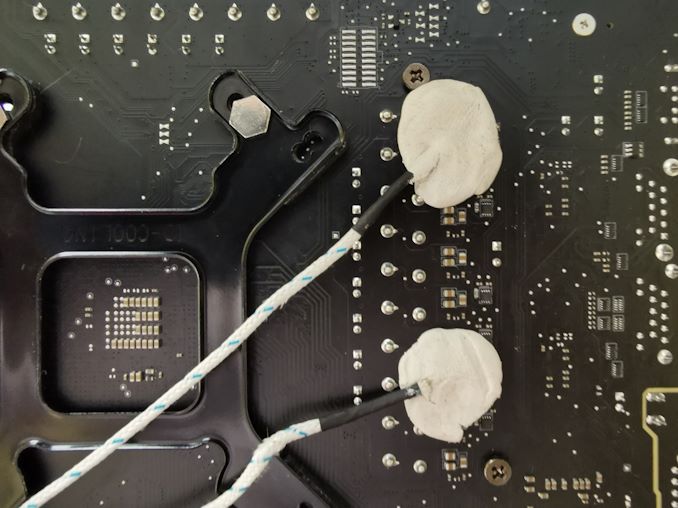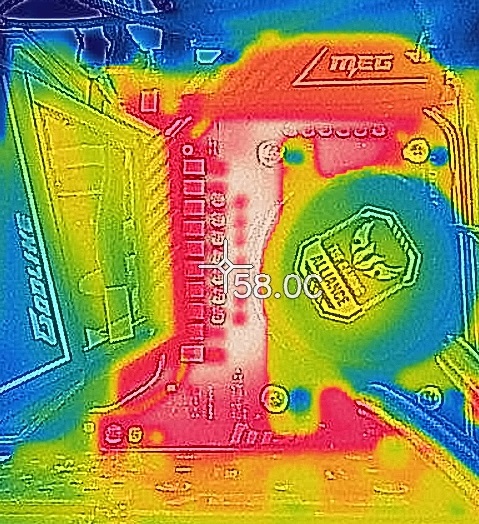The MSI MEG X570 Godlike Motherboard Review: Thor's Flagship
by Gavin Bonshor on August 28, 2019 12:00 PM EST- Posted in
- Motherboards
- AMD
- MSI
- 10G Ethernet
- Ryzen
- PCIe 4.0
- Ryzen 3000
- X570
- X570 Godlike
- MEG
Power Delivery Thermal Analysis
One of the most requested elements of our motherboard reviews revolves around the power delivery and its componentry. Aside from the quality of the components and its capability for overclocking to push out higher clock speeds which in turn improves performance, is the thermal capability of the cooling solutions implemented by manufacturers. While almost always fine for users running processors at default settings, the cooling capability of the VRMs isn't something that users should worry too much about, but for those looking to squeeze out extra performance from the CPU via overclocking, this puts extra pressure on the power delivery and in turn, generates extra heat. This is why more premium models often include heatsinks on its models with better cooling designs, heftier chunks of metal, and in some cases, even with water blocks such as the ASUS ROG Crosshair VIII Formula.

Two K-Type Thermal Probes attached to the rear of the power delivery on the MSI MEG X570 Godlike
Testing Methodology
Out method of testing out if the power delivery and its heatsink are effective at dissipating heat, is by running an intensely heavy CPU workload for a prolonged method of time. We apply an overclock which is deemed safe and at the maximum that the silicon on our AMD Ryzen 7 3700X processor allows. We then run the Prime95 with AVX2 enabled under a torture test for an hour at the maximum stable overclock we can which puts insane pressure on the processor. We collect our data via three different methods which include the following:
- Taking a thermal image from a birds-eye view after an hour with a Flir Pro thermal imaging camera
- Securing two probes on to the rear of the PCB, right underneath CPU VCore section of the power delivery for better parity in case a probe reports a faulty reading
- Taking a reading of the VRM temperature from the sensor reading within the HWInfo monitoring application
The reason for using three different methods is that some sensors can read inaccurate temperatures, which can give very erratic results for users looking to gauge whether an overclock is too much pressure for the power delivery handle. With using a probe on the rear, it can also show the efficiency of the power stages and heatsinks as a wide margin between the probe and sensor temperature can show that the heatsink is dissipating heat and that the design is working, or that the internal sensor is massively wrong. To ensure our probe was accurate prior to testing, I personally binned 10 and selected the most accurate (within 1c of the actual temperature) for better parity in our testing.
For thermal image, we use a Flir One camera as it gives a good indication of where the heat is generated around the socket area, as some designs use different configurations and an evenly spread power delivery with good components will usually generate less heat. Manufacturers who use inefficient heatsinks and cheap out on power delivery components should run hotter than those who have invested. Of course, a $700 flagship motherboard is likely to outperform a cheaper $100 model under the same testing conditions, but it is still worth testing to see which vendors are doing things correctly.
Thermal Analysis Results

We measured 58°C on PCB between the CPU socket and power delivery
The MSI MEG X570 Godlike is running a 14-phase design for the CPU VCore section. This includes an International Rectifier IR35201 running in a 7+1 configuration with seven IR3599 doublers on the rear of the PCB; the SoC section is running four phases off a single IR3599 which splits the signal into four. As far as designs go, this is MSI's best AMD power delivery that I can recall seeing, although I still find it a little odd that the SoC section is split into four, but through one IR3599 doubler in quad mode. Perhaps this will yield some benefits and gains for extreme overclockers, but it's not an issue for general users to be concerned about. The heatsink is very similar to the MSI MEG X570 Ace and uses the same design. The power delivery heatsinks are interconnected by a heat pipe which stretches around the left side of the memory slots and down into the actively cooled X570 chipset heatsink.
As we get more results, we will endeavour to update this chart when more models have been tested
Note - The ASRock B450 Gaming ITX-ac model crashed instantly every time the small FFT torture test within Prime95 was initiated. At anything on the CPU VCore above 1.35 V would result in instant instability. The Ryzen Master auto-overclocking function failed every time it tried to dial in settings, but it does however operate absolutely fine at stock, and with Precision Boost Overdrive enabled. Either the firmware is the issue, or the board just isn't capable of overclocking the Ryzen 3700X with extreme workloads with what is considered a stable overclock on the X570 chipset. We will re-test this in the future.
The power delivery on the MSI MEG X570 Godlike actually runs slightly cooler in our testing which can be explained by having a slightly better 14+4 power delivery versus the 12+2 design on the MSI MEG X570 Ace. More phases usually generate less heat overall as each phase is active for a shorter period of time, which does show in our testing. We ran our AMD Ryzen 7 3700X testbed sample at 4.1 GHz with a CPU VCore of 1.45 V which is consistent with other models we have tested to try and generate as much heat as possible. The power delivery probe output reading was 59°C after an hour of testing, while the VRM temperature sensor gave us a reading of 61°C. The MSI MEG X570 Godlike does well under our testing method and there should be no issues when overclocking the current Ryzen 3000 processors, as we found that we hit CPU thermal limitations before anything else.











116 Comments
View All Comments
Oxford Guy - Thursday, August 29, 2019 - link
"As far as security issues they have both had their own issues over the years, although Intel has had a fair amount more."I don't think so. Intel's recent security track record is abysmal when compared with AMD's.
Qasar - Friday, August 30, 2019 - link
Sweetbabyjays the savings you are referring to for the MSI and Gigabyte boards, guess where it goes, the the HSF to cool that CPU, and remember, a 50 or 60 buck cooler, isnt going to cut it. you will need to get a mid high, to a high end cooler to keep that 9900k running at 4.8 ghz. and BTW... so what if the 9900k can hit 4.8 or 5 ghz.. big deal.. the Ryzen cpus are performing with in a few % of the intel equivent cpus while being 600+ MHz slower, all because the IPC is better then intels right now, once the ryzen cpus get their clocks higher, the gap, could flip flop... clock speed isnt the end all be all in performance, IPC is.. and AMD, for the time being, has the better IPC."
Then you say in another comment "they've won the performance and value games both at once." i never knew 10% less performance is better." it is when, again, the 10% deficit, is also at lower clocks compared it intel, as again.. IPC is better
Irata - Thursday, August 29, 2019 - link
First of all, there are many lower price options for X570.And to add to this, a high end Z390 motherboard is not cheaper - you can actually even spend more and if high Ghz is your aim, that is what you will need. Plus a high end ($$$) cooling solution.
Sweetbabyjays - Thursday, August 29, 2019 - link
True there are many X570 boards for cheaper, which in my opinion makes this board in particular, pointless. Spending $700 on an AM4 motherboard is in my opinion pure stupidity.The Z390 Godlike motherboard is available for $100 US cheaper. So a product for product comparison. Additionally, there are many other Silicon Lottery QVL Z390's that you can purchase for literally 1/3 of the price of this board. Furthermore, you can overclock a 9900k to 4.8 on pretty much any Z390/370 board.
If you're planning on getting your 3700x to 4.2GHz, you're not going to get there with a stock cooler, so you still need an expensive cooler.
AMD's main game is to be the value for money competitor, what i'm saying is a $700 motherboard at AM4 level literally takes that advantage and scrubs it. The only time that Zen 2 CPUs become the value option is when you need more than 8c/16t, or if you're going to go with an older AM4 chipset.
AshlayW - Thursday, August 29, 2019 - link
Then we both agree that this motherboard is pointless. It is, 700 bucks on this is a stupid thing, but when a decent X570 is 150-200 bucks, no problem. 3700X+X570 is hands down the better solution (read: also for gaming builds) than the 9900K+Z390 when all is considered.AMD doesn't have to be the "Value for money competitor" anymore, hon, they've won the performance and value games both at once. Ryzen is a premium brand now, and just happens to offer better value also. 3950X will render Intel's entire HEDT completely pointless, and 3900X already does half of it.
Sweetbabyjays - Thursday, August 29, 2019 - link
I totally agree that 3900x and 3950x really are the final nails in the X299 coffin.AshlayW - Thursday, August 29, 2019 - link
Or you could be a Smart consumer and get a B450 + Ryzen 9 3700X, for the same price as the 9900K alone, and have 90% the performance in every single scenario and having saved over a hundred dollars, considering you didn't have to buy the cooler, also? Oh, and the socket isn't dead-end and actually has an upgrade path.AshlayW - Thursday, August 29, 2019 - link
Ryzen 7*Sweetbabyjays - Thursday, August 29, 2019 - link
"B450 + Ryzen 7 3700X" I agree, this is a much more logical approach for most gamers and content creators on a budget.Oxford Guy - Thursday, August 29, 2019 - link
I'm also wondering why people ALWAYS push the 9900K instead of the 9700K to gamers, when 8 threads is enough for games and will be for long enough.